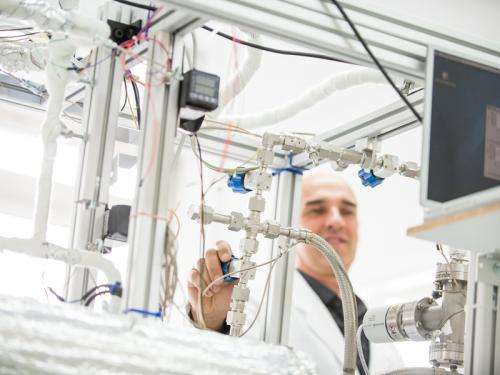Particle physics for internal security

ETH spin-off Arktis Radiation Detectors Ltd produces special detectors that are in demand for internal security and combating terrorism. The plan moving forward is to develop a mobile detector within the frame of a research project, for which financing from the EU is underway.
The technology developed by ETH spin-off Arktis Radiation Detectors Ltd originates from research conducted at ETH by the particle physicists Giovanna Davatz and Rico Chandra. Arktis was founded in 2007 and since then the company has attracted considerable attention, and even has the US Department of Homeland Security as a research investor. The Arktis detectors can reliably sense radioactive material even if it is shielded with a lead jacket. They react not only to highly radioactive material such as caesium and americium, which are considered possible source materials for dirty bombs, but also to the plutonium and uranium needed for atomic bombs. "Both of these, in particular uranium, have comparatively weaker radiation emissions and thus are difficult to detect. This is especially true when they are shielded by lead containers," emphasises Davatz, co-founder of Arktis.
Mobile detector for heavy cargo
Arktis' customers include government agencies from the UK and the US. They finance Arktis in the supply of equipment that can detect smuggled radioactive material during customs clearance or at container ports. Currently, the Arktis team is collaborating with seven partners – including a group led by ETH professor André Rubbia – as part of a project financed by the European Union to enhance one of the company's recently developed detectors and to expand its range of products. "The goal is to build a modular and compact mobile detector system," explains Davatz.
Normally, detectors are installed as a permanent facility at seaports, where cargo containers are pushed through them in a manner similar to a car wash. The new mobile device is intended to be taken to the allegedly dangerous containerised cargo where it can track it on-site. It is also intended to help in emergency situations, such as investigating an abandoned suspicious object. The prototype is to be tested in the near future by various European customs authorities.
All detectors developed by Arktis use cost-effective noble gases such as xenon, argon or helium-4 as their detection medium. The compressed gas in the detector acts as a scintillator. Rays that penetrate the gas excite the gas particles in the detector and place them in a higher energy state. When they return to their base state, they emit scintillation light that provides information about the energy of the original radiation and from which conclusions about the type of radiation can be drawn.
Distinction between the dangerous and the harmless
Arktis detectors are very fast and therefore able, for example, to react to fast neutrons resulting from nuclear fission. At the same time, they filter out naturally occurring neutrons from cosmic background radiation. As the detectors are designed to include the time factor during measurements, they supply more information than conventional detectors and thus make it possible to distinguish between dangerous material and harmless cargo.
This is not possible with conventional detectors. They operate on a similar principle to a classic Geiger counter, which registers the presence of radiation but does not reveal any further information about its source. Conventional detectors are not able to determine adequately whether they are dealing with particles from dangerous cargo or with harmless radiation from safe materials, such as fertiliser or cat litter, explains Davatz. As a result, the older technologies often trigger false alarms.
More information: www.arktis-detectors.com/
Provided by ETH Zurich


















